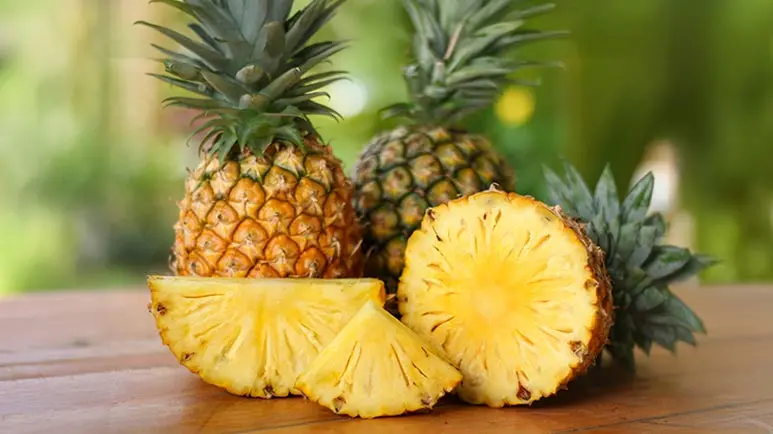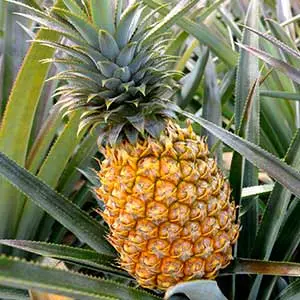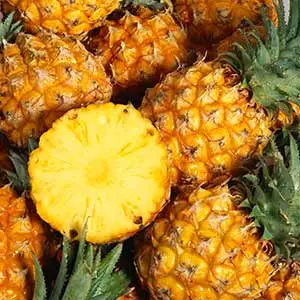Pineapple: Is This Tropical Fruit the Secret to Better Pet Health?
This refreshing tropical fruit offers a unique compound that enhances digestion, making it a great addition to your list of healthy, natural snacks for your pet.

STORY AT-A-GLANCE
- Pineapple contains a unique compound called bromelain, which has anti-inflammatory and antibacterial potential, according to animal studies
- Aside from bromelain, pineapple contains other nutrients that can support your pet's health, such as vitamin C, beta-carotene and choline
- You can serve raw pineapple to your pet or freeze the chunks first to help your pet cool down during hot summer days
Editor's Note: This article is a reprint. It was originally published April 11, 2019.
Pineapple is one of the most popular fruits around the world, and for good reason. Its sweet, tangy flavor goes very well with fruit salads or can be enjoyed on its own as a refreshing snack. It's even used as an ingredient in cooking savory dishes. But how about your furry friend? Can they enjoy some pineapple slices like you do?
As it turns out, pineapple can be a tasty pet treat as long as the serving is less than 10% of your pet's daily intake. In the right manner, it can even be added to your pet's nutritionally adequate, species-appropriate diet.
The Secret of Pineapple: Bromelain
Pineapple's most distinguishable nutrient is bromelain, which is a group of enzymes found in the flesh.1 Among humans, bromelain has been used to help provide relief from sinusitis, surgical trauma and bronchitis.2 Interestingly, bromelain can be a boon to your four-legged friend as well.
Animal research on bromelain is limited, but the results lean toward the positive side. For example, in a 1997 study published in Gastroenterology, bromelain exhibited antibacterial properties that may help reduce diarrhea in animal models,3 with a second study confirming similar results. In a study done on pigs, bromelain reduced the amount of E. coli bacteria present in the GI tract. Pigs given bromelain also had better growth.4
Bromelain has been found to help manage inflammation in animals. In one animal study, researchers noted reduced intestinal inflammation5 and, in another study, bromelain helped reduce the symptoms of edema.6
Pineapple Fun Fact

Depending on the conditions, pineapples can reach very big sizes. In 2011, a gardener from Australia named Christine McCallum was able to harvest a pineapple weighing 8.28 kilograms (18.25 pounds) and measuring 32 centimeters (12.59 inches) long. It took two years for the fruit to grow.7
Other Phytonutrients and Vitamins of Pineapple
Aside from bromelain, pineapple contains other nutrients that may support your pet's well-being. A single tablespoon alone can provide 57.8 micrograms of beta-carotene, 0.56 milligrams of choline and 78.9 milligrams of vitamin C.8 Let's examine how each of these nutrients function.
Beta-carotene is a precursor phytonutrient/carotenoid that is converted into vitamin A. One of the most notable benefits of beta-carotene is supporting immune system function, especially if you have an older dog. In a study published in 2003, researchers noted that increasing beta-carotene intake "significantly restored immune responses in older dogs when compared with their age-matched controls and younger counterparts."9
The beta-carotene in pineapple may help support your pet's eyesight as well. In a study published in the Journal of Nutritional Science, a mixture of carotenoids, which includes beta-carotene, improved the eyesight in the test dogs.10
As for vitamin C, it is an essential nutrient that must be obtained regularly through your pet's diet. Its importance is well-known in human nutrition, and the same applies to animal nutrition. A study published in the Canadian Journal of Veterinary Research noted that vitamin C functions as "a cofactor for enzymes involved in the biosynthesis of collagen, carnitine and norepinephrine." Furthermore, it has antioxidant qualities that may help squash reactive oxygen species and reactive nitrogen species.11
Choline, according to a study published in Veterinary World, is considered to be an important nutrient. It plays multiple roles in an animal's body, such as the synthesis of neurotransmitters, muscle function and hepatic lipid transport. Researchers also noted that dogs may benefit from choline's ability to "promote long-term health, in particular, heart, brain and liver health."12
Did You Know?

A pineapple plant typically takes 32 to 46 months to grow the spiky fruit we all know and love. What's interesting about the plant is that it only produces one fruit in its entire lifetime.13
Is Pineapple Safe for Your Pet?
Misinformation about many healthy fruits, vegetables, nuts and seeds abounds on the internet. This is because websites have labeled all risks (such as the risk of over-consumption causing gastrointestinal issues, or choking on too large of pieces or pits) as "toxicities," which isn't true but has managed to confuse millions of pet lovers, nonetheless. In the case of pineapple, the rind can be a choking hazard, therefore you might see it listed as a dangerous fruit on some websites.
Pineapple can be a delicious and nutritious treat for your pet, as long as it's given in appropriate amounts.14 Don't worry about potential toxicity of bromelain in your pet. According to one study wherein dogs received 750 milligrams of bromelain per kilogram of weight, no toxicity was reported.15
When it comes to feeding pineapple, it's the sugar content that you need to be aware of. A single tablespoon of pineapple contains 1.01 grams of sugar.16 Therefore, it's important that you limit the serving to treats. A good strategy is rotating it with other healthy treats throughout the day.
As a general rule, treats should comprise less than 10% of your pet's daily caloric intake. These foods are meant to be given as a healthy snack, not a replacement diet. The bulk of your pet's nutrition should still come from nutritionally complete meals.
Top Pineapple Producers

The top five countries that produce pineapples (in descending order) are Costa Rica, the Philippines, Brazil, Thailand and India.17 Production in the U.S. is small and concentrated in Hawaii and Puerto Rico, as well as Florida and California.18

Tips for Choosing and Feeding Pineapple to Your Pet
"When it comes to feeding pineapple to your pet, conventionally grown sources are fine."
According to the Environmental Working Group (EWG), pineapple ranks third in their Clean Fifteen list. This means that conventionally grown pineapples sold in the U.S. have minimal amounts of pesticides and are clean and safe to eat.19 As for preparing pineapple for your pet, here's an easy-to-follow procedure by Better Homes & Gardens:20
Procedure:
- Rinse and clean the pineapple skin first. Then, cut off the green crown and the stem end of the fruit.
- Let the pineapple stand on one end and peel the skin from top to bottom. Try to cut away as near as the skin as you can so you don't waste too much pineapple flesh. Afterward, create wedge-shaped grooves to remove the pineapple eyes.
- Cut the pineapple into four pieces from top to bottom, then remove the core from each quarter slice that you just made.
- Cut the slices into small, bite-sized chunks appropriate for your pet.
Serving pineapple raw is the best way of giving your pet the goodness of this fruit. When it's hot, you can also freeze pieces before serving them to your dog, making sure the size is large enough to not create a choking hazard (do not give frozen foods to animals that try to swallow foods whole). Under no circumstances should you be feeding canned pineapple chunks to your pet because the excess sugar in these products may cause health problems.21
Sources and References
- 1 NCCIH, "Bromelain"
- 2 Biotechnol Res Int. 2012; 2012: 976203, Abstract
- 3 Gastroenterology. 1997 Jul;113(1):175-84, Abstract
- 4 Gut. 1998 Aug;43(2):196-202, Abstract
- 5 Front. Immunol., 10 November 2017
- 6 Biomed Rep. 2016 Sep; 5(3): 283–288, Clinical Applications
- 7 The Daily Telegraph, November 30, 2011
- 8,16 USDA, "Pineapple, raw, all varieties"
- 9 J Vet Intern Med. Nov-Dec 2003;17(6):835-42, Abstract
- 10 J Nutr Sci. 2016; 5: e18, Abstract
- 11 Can J Vet Res. 2006 Oct; 70(4): 305–307, Abstract
- 12 Vet World. 2019 May; 12(5): 671–676, Discussion
- 13,21 Gardening Know How, "Pineapple Plant Fruiting: Do Pineapple Plants Fruit More Than Once?"
- 14 AKC, July 26, 2022
- 15 Biotechnol Res Int. 2012; 2012: 976203, Toxicity of Bromelain
- 17 Banana Link, "All About Pineapples"
- 18 Blue Book Services, "Pineapple" (Archived)
- 19 EWG, "Clean Fifteen"
- 20 Better Homes and Gardens, June 20, 2024











